A kit lens is a "starter" lens which can be sold with an interchangeable-lens camera such as a single-lens reflex camera. It is generally an inexpensive lens priced at the lowest end of the manufacturer's range so as to not add much to a camera kit's price. The kit consists of the camera body, the lens, and various accessories usually necessary to get started in SLR photography. A kit lens can be sold by itself outside of a kit, particularly the ones that are moderately expensive; for instance a kit lens included in a prosumer SLR kit is often marketed as an upgrade lens for a consumer SLR. In addition, retailers often have promotions of standalone low-end SLR bodies without the lens, or a package that bundles the SLR body with one or two more expensive lenses.

The Olympus E-3 was until 2010 Olympus Corporation's flagship camera, positioned as a professional DSLR camera. It is the successor to the Olympus E-1, which was launched in November 2003. The E-3, originally codenamed Olympus E-P1, was announced on 17 October 2007. The E-3, like the other cameras in the Olympus E-series, conforms to the Four Thirds system. It was succeeded in 2010 by the Olympus E-5 professional DSLR flagship camera.
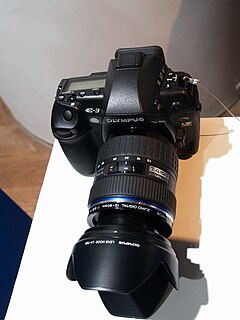
The Olympus Corporation Zuiko Digital ED 12–60mm 1:2.8–4 SWD is a Four Thirds System Pro series lens, sold in a kit with the Olympus E-3 camera body and available separately.
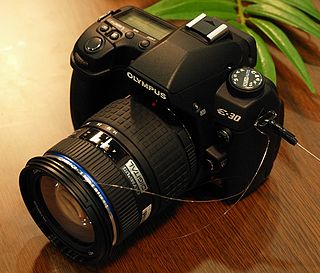
The Zuiko Digital 14–54 mm f/2.8–3.5 II is a Four Thirds System Pro series lens by Olympus Corporation, sold in a kit with the Olympus E-30 camera body and available separately. It is positioned just below the Olympus Zuiko Digital ED 12–60mm 1:2.8–4 SWD in terms of size, weight, focusing speed, price and focal length range, while having larger apertures. It replaces the Olympus Zuiko Digital 14–54mm 1:2.8–3.5, which had a longer minimum focusing distance.
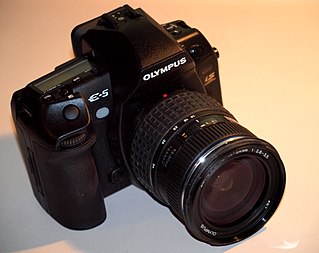
The Olympus E-5 was Olympus Corporation's flagship camera, positioned as a professional DSLR camera. It is the successor to the Olympus E-3, which was launched on October 17, 2007. The E-5 was announced on September 14, 2010. The E-5, like the other cameras in the Olympus E-series, conforms to the Four Thirds System.

The Zuiko Digital 25mm f/2.8 is a Four Thirds System standard-series lens manufactured by Olympus, sold both separately and bundled in a kit with the E-420 camera.
Zuiko is a brand of optical lenses made by Olympus Corporation that was used up to and including the Four Thirds system era. At the inception of the Micro Four Thirds system in 2008, new lenses for that system started to be branded as M.Zuiko Digital.
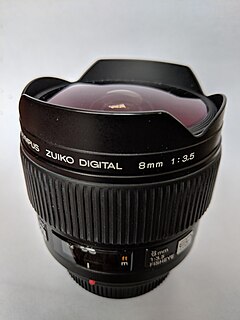
The Olympus Zuiko Digital ED 8mm f/3.5 Fisheye is an interchangeable "full-frame" or diagonal fisheye lens for Four Thirds system digital single-lens reflex cameras, announced by Olympus Corporation on June 30, 2005.

The Olympus Zuiko Digital ED 50mm 1:2.0 Macro is an interchangeable macro lens for the Four Thirds system with 1:2 maximum magnification. It was announced by Olympus Corporation on June 24, 2003.
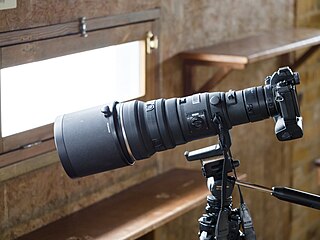
The Olympus Zuiko Digital 300mm 1:2.8 is an interchangeable camera lens announced by Olympus Corporation on June 24, 2003. As the largest and heaviest lens in the Zuiko Digital line, the ZD300mm f/2.8 was given the nickname "Big Tuna".

The Olympus Zuiko Digital 11-22mm 1:2.8-3.5 is an interchangeable wide angle zoom lens for the Four Thirds system. It was announced by Olympus Corporation on June 24, 2003.
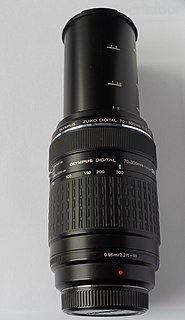
The Olympus Zuiko Digital ED 70-300mm 1:4.0-5.6 is an interchangeable telezoom lens for Four Thirds. It was announced by Olympus Corporation on June 26, 2007.
The Olympus Zuiko Digital ED 90-250mm 1:2.8 is an interchangeable telezoom lens announced by Olympus Corporation on February 17, 2005.
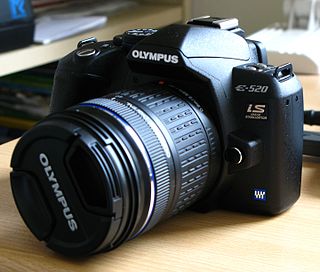
The Olympus Zuiko Digital ED 40-150mm 1:4.0-5.6 is an interchangeable moderate telezoom lens for the Four Thirds system. It was announced by Olympus Corporation on September 27, 2004.
The Olympus Zuiko Digital ED 18-180mm 1:3.5-6.3 is an interchangeable superzoom lens announced by Olympus Corporation on September 26, 2005.

The Olympus Zuiko Digital ED 14-42mm 1:3.5-5.6 is an interchangeable kit zoom lens announced by Olympus Corporation on September 14, 2006.

The Olympus Zuiko Digital ED 14-35mm 1:2.0 SWD is an interchangeable camera lens announced by Olympus Corporation on February 17, 2005.
Olympus M.Zuiko Digital ED 8 mm f/1.8 Fisheye Pro is an optically corrected fisheye lens.

The Zuiko Digital 14–54 mm f/2.8–3.5 is a Four Thirds System High Grade series lens by Olympus Corporation, initially sold in a kit with the Olympus E-1 camera body and also available separately. Three glass aspherical lenses are used in its optical formulation. It was positioned as an upgrade to the 14-45mm kit lens in terms of focal length range while having larger apertures. It was replaced as the premium kit lens by the Olympus Zuiko Digital ED 12-60mm f/2.8-4 SWD with the release of the E-3, and later was directly replaced by the Olympus Zuiko Digital 14-54mm f/2.8-3.5 II, which is more suited for mirror-up or mirrorless operation.

The Olympus Zuiko Digital ED 50-200mm F2.8-3.5 is an interchangeable lens for Four Thirds system digital single-lens reflex cameras announced by Olympus Corporation during the system launch on June 24, 2003. The SWD version is equipped with an ultrasonic motor for focusing, and was introduced in 2007 with the Olympus E-3.















